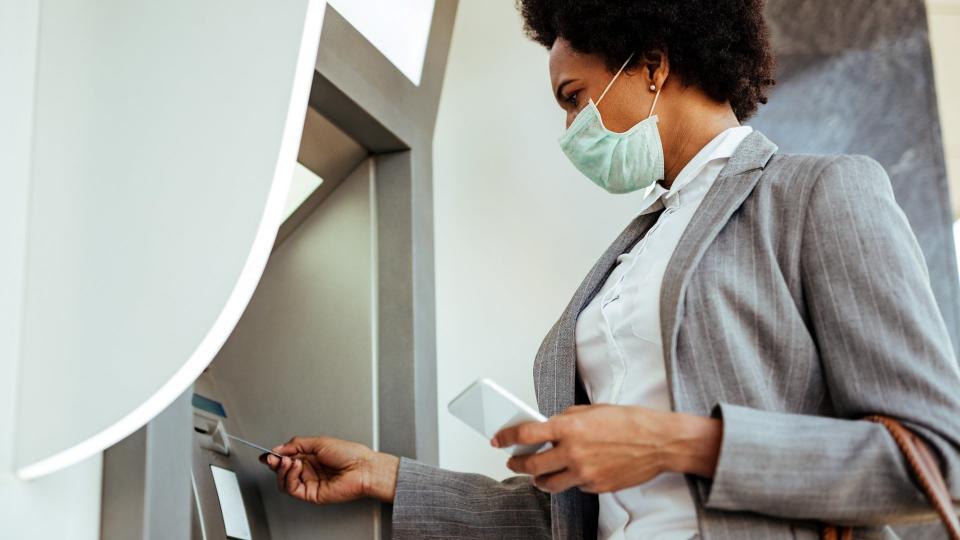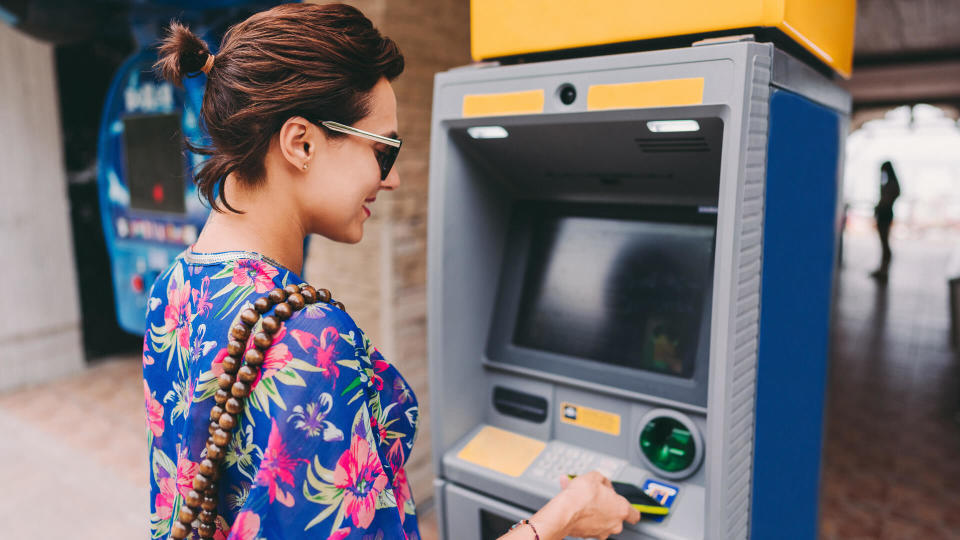These Fees Have Cost Americans $11.6B During the Pandemic — Here’s How To Avoid Them

Being careless with a few dollars here and there can end up costing you a small fortune over time. Whether it’s accidentally overdrawing your bank account or choosing an out-of-network ATM in a pinch, you’re essentially throwing away money that could be earning interest in a high-yield savings account. Paying the occasional banking fee might not seem like a big deal at first, but those mistakes can really add up.
Related: How To Avoid Wasting Money on Bank Fees
Fintech company Stilt reports that even during the first three months of the COVID-19 pandemic, as millions struggled to make ends meet, Americans paid about $11.6 billion in bank fees. If this sounds familiar, find out how you can stop yourself from losing thousands of dollars over your lifetime — and missing out on major opportunities to grow your wealth.
Last updated: Jan. 21, 2021

Bank Customers in the US Losing Billions
The COVID-19 pandemic has been financially devastating to millions of Americans. As if that’s not bad enough, many are also being hit with bank fees while struggling to pay the bills.
Banks charged more than $4.15 billion in non-sufficient funds fees during the second quarter of 2020, according to Stilt — at an average of $29.67 per NSF transaction. Additionally, banks charged more than $5.09 billion in overdraft fees during this same time period at an average of $28.32 per overdraft.
See: 10 Best Options for Free Checking With No Minimum Balance

Most People Pay Banking Fees
In addition to fees for items such as overdrafts and non-sufficient funds, you might also get slapped with monthly maintenance fees or monthly service fees if you don’t meet minimum balance or other requirements. A GOBankingRates survey found that the average American pays $7 in banking fees every month. Here’s a breakdown of certain banking costs:
Common Bank Fees | Estimated Costs |
Monthly maintenance fee (savings) | $1-$10 |
Monthly service fee (checking) | $3-$20 |
Non-sufficient funds | $25-$37 |
Overdraft | $34-$36 |
Transfer from savings | $10-$12.50 |
Estimated amounts for common bank fees were sourced from GOBankingRates’ database and the Center for Responsible Lending. | |

Bank Fees Can Snowball Into Thousands in Lost Savings
If you avoided that $7 monthly fee and instead put it into a savings account with an annual percentage yield of 0.09%, that would add up to an additional $91 in savings each year. Over 50 years, that would amount to $4,303.25 if the money had been deposited in an average savings account — or an even higher $4,843.46 with a high-interest savings account that has a 0.50% annual percentage yield, such as the one offered by FNBO Direct.
“I purposely choose my banks to avoid fees and open up checking accounts with low or no monthly minimums, so I don’t have to think about fees,” said banking consumer Stacy Caprio. “I also make sure there are no fees for writing checks or simply having cash in the bank. I’m doing the bank a favor by putting my cash there, and I know there are plenty of banks who don’t charge unreasonable fees, so I stay far away from those that do.”
However, many Americans don’t share Caprio’s mindset.
Discover: How Much Debt Americans Have at Every Age

Most People Are Willing to Pay Unnecessary Bank Fees
Even though 34% of the respondents in GOBankingRates’ survey stated that their goal was to save more money in a regular savings account, most aren’t considering shopping for a better bank. In fact, 88% of the respondents stated they weren’t planning to switch banks in 2019 — even if their bank charges unnecessary fees.
As long as Americans keep paying various monthly maintenance fees, overdraft fees, out-of-network ATM charges and more, they’ll find less money in their bank accounts to put toward their financial goals.
Read More: 62% of Americans Don’t Know Banking Basics — and It’s Costing Them

Major Banks Cash In on Overdraft Fees
Here’s a breakdown of how much each major U.S. bank charges for overdrawing your account:
Bank | Fee Amount |
Chase overdraft fee | $34 |
Bank of America overdraft fee | $35 |
Wells Fargo overdraft fee | $35 |
Citibank overdraft fee | $34 |
U.S. Bank overdraft fee | $36 |

Overdraft Fees Add Up Fast
The average overdraft fee among the five biggest banks is approximately $35 — which means if you’re not careful enough, you could end up wasting a hefty amount of money on essentially nothing. For example, overdrawing your account just twice a month will cost you a whopping $70.
If you still think overdraft fees aren’t that big of a deal, consider the big picture: If you overdraft once a month for 30 years, you would waste about $12,600. If you overdraft twice a month for 30 years, the amount would double to more than $25,000 — and that’s money you could have been stashing in a high-interest savings account.

Most People Aren’t Worried About Overdraft Fees
When it comes to fears about banking, only 13% of Americans are most scared of incurring bank fees, according to the GOBankingRates survey. Respondents were much more afraid of someone stealing their account and/or personal information, someone stealing money from their account, or losing their bank debit card and/or credit card. However, overdraft fees shouldn’t be deemed trivial.
“The cost of an overdraft fee might not seem make-or-break, but it’s important to remember that financial hardship is often what leads one to overdraw in the first place,” said Sean Messier, a credit industry analyst. “An overdraft fee on top of whatever other debts or financial obligations you’re already struggling with could cause serious mental and financial stress.”

Don't Overlook ATM Fees
The average ATM fee is only $2.50, which is the amount the five largest banks in the U.S. — Chase, Bank of America, Wells Fargo, Citibank and U.S. Bank — charge their customers for using non-network ATMs in the U.S. and its territories. Although these fees are much less expensive than overdraft fees, that doesn’t mean they can’t drain your finances.
For example, if you make an out-of-network ATM transaction every other day for the next 30 years, you’ll rack up more than $13,500 in fees. If you happen to make the same type of transaction every day for the next 30 years, you’ll spend around $27,000 on out-of-network fees.
The mindless act of wasting money on unnecessary fees can heavily impact your financial goals. Just one year of using an out-of-network ATM every other day equals more than $450. Those fees could easily be redirected to the No. 1 savings goal of the respondents in GOBankingRates’ survey: saving more money for emergencies.

How to Avoid ATM Fees
So, what’s the best way to avoid ATM fees? “Do some research about ATMs,” said Cyndie Martini, CEO and president of Member Access Processing, America’s largest aggregator of card services for credit unions.
“Banks and credit unions typically offer a network of surcharge-free ATMs, usually listed on their websites,” Martini said. “If you need cash, get cash back when you use your card at the grocery or other stores offering cash back.”
Related: Newest Bank Promotions, Bonuses and Offers for October 2020

Research the Latest Interest Rates
Another way to grow your money is to find the best interest rates possible. Here’s a look at the national rates and rate caps for different types of deposit accounts, according to the FDIC:
Deposit Accounts | National Rates | Rate Caps |
Savings | 0.05% | 0.80% |
Interest checking | 0.04% | 0.79% |
Money market | 0.07% | 0.82% |
One-month CD | 0.05% | 0.80% |
Three-month CD | 0.08% | 0.83% |
Six-month CD | 0.12% | 0.87% |
12-month CD | 0.18% | 0.93% |
24-month CD | 0.23% | 0.98% |
36-month CD | 0.27% | 1.02% |
48-month CD | 0.30% | 1.05% |
60-month CD | 0.36% | 1.11% |
National rates for deposit products were sourced from the Federal Deposit Insurance Corp. for the week of Oct. 12, 2020. | ||

The Best Interest Rates Make a Huge Difference
Shopping around for the best interest rate on deposit accounts is well worth it when you understand exactly what you have to gain.
For example, let’s say your current bank offers the national savings rate of 0.05%, which means that over the course of 30 years at a daily compounding rate you can earn approximately $15 for every $1,000 you save. Now, if you shop around and find a bank offering a rate of 0.70% — which is one of the best savings account interest rates available — you can earn approximately $234 for every $1,000 you save.
In this case, not shopping around forces you to miss out on nearly 16 times the amount of interest earned over 30 years.

Make Your Money Work for You
Aside from certificates of deposit, some of the best rates are attached to money market accounts, interest checking accounts or high-yield savings accounts. However, according to a separate GOBankingRates survey, only 10% or less of respondents have their money in either money market, CD or bank IRA accounts — which means many people aren’t earning the highest interest rates available.
Related: Cashier’s Check vs. Certified Check

Why You Should Switch To an Online Bank
There are many reasons to switch to an online bank, including the following:
Online banks have less overhead than brick-and-mortar banks, so they can pass those savings on to customers.
They often have sizable fee-free ATM networks.
Online banks offset their already low fees with higher interest rates on checking and savings accounts, Messier said.

Online Banks Offer Higher Average Interest Rates
The average savings APY is 0.60% at five of the largest online banks — Synchrony Bank (0.65%), Ally Bank (0.60%), American Express National Bank (0.60%), Discover Bank (O.60% APY) and CIT Bank (0.55%). In contrast, the average standard savings APY is less than 0.02% at the five largest brick-and-mortar banks in the U.S.: Chase (0.01%), Bank of America (0.01%), Wells Fargo (0.01%), Citibank (0.04%) and U.S. Bank (0.01%).
To put these rates in perspective, consider that for every $1,000 you deposit in an online savings account with a 0.60% APY compounded daily, you’ll earn $197.22 over 30 years. For every $1,000 you deposit in a brick-and-mortar savings account with a 0.02% APY compounded daily, you’ll earn only $6.02 over 30 years — a difference of more than $191.
Depending on the total amount of your deposit, you could lose thousands of dollars in potential interest over your lifetime if you choose to save your money in a brick-and-mortar bank instead of an online bank.

Most People Don’t Use Online Banks
Alarmingly, only 22% of respondents in GOBankingRates’ survey said they have deposit accounts with online banks, which means more than three-quarters of American bank account customers could be making a very expensive mistake.
Don’t take for granted that you’re getting the best deal at your current bank. Instead, shop around for a bank that will give you the best rates and allow you to reach your savings goals faster.
More From GOBankingRates
Gabrielle Olya, Grace Lin and Cynthia Measom contributed to the reporting for this article.
This article originally appeared on GOBankingRates.com: These Fees Have Cost Americans $11.6B During the Pandemic — Here’s How To Avoid Them
